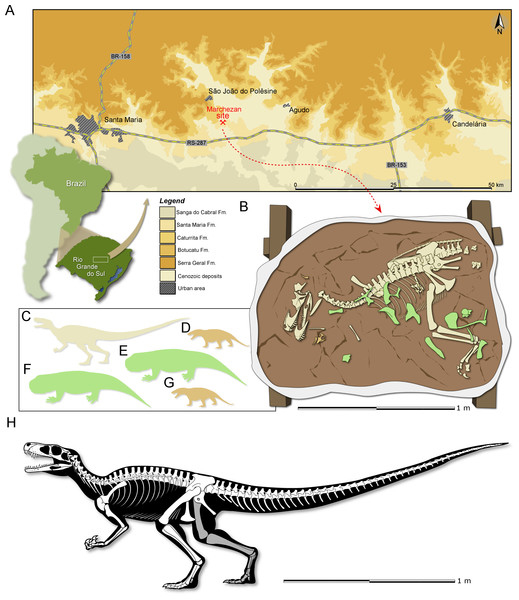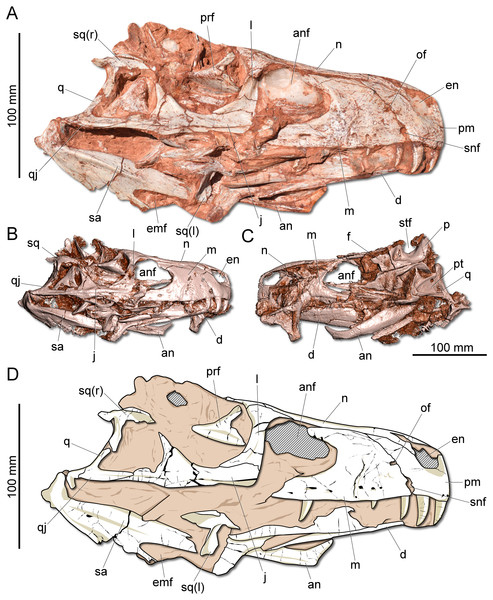Gnathovorax cabreirai – Triassic Terror Sheds Light on the Origins of Predatory Dinosaurs
A number of revisions to the Dinosauria have occurred in recent years. Perhaps most famously, by the 2017 scientific paper published by Baron, Norman and Barrett, that redefined the dinosaurs along the lines of a model proposed by Henry Govier Seeley back in the late 1880s*. In this study, the enigmatic and quite poorly known herrerasaurids (Herrerasauridae), with their confusing array of dinosaur and non-dinosaur anatomical traits, were not classified as theropods, instead they are placed on the branch of the family tree associated with the Sauropodomorpha.
This paper, therefore, suggested that meat-eating actually evolved twice, once in the herrerasaurids and then again in the Theropoda.
A Taxonomic Debate
This scientific paper has certainly opened up the taxonomic debate, however, the discovery of a remarkably-well preserved skeleton of a herrerasaurid from southern Brazil has helped scientists to get a much better idea of the Herrerasauridae and this, in turn, has provided a new insight into how these reptiles fit into the wider Dinosauria picture.
Location Map and Geological Setting Plus Skeletal Drawing of the Newly Described Herrerasaurid Gnathovorax cabreirai

Picture credit: PeerJ
Hardly Known Herrerasauridae
Fragmentary fossils associated with possible members of the Herrerasauridae have been found in North America and Europe, but the three species of herrerasaurids that most palaeontologists agree upon (Herrerasaurus, Staurikosaurus and Sanjuansaurus) all herald from the Late Triassic of South America. Trouble is, as a dinosaur family there is not a lot of fossil material to study. Writing in the academic journal PeerJ, a team of scientists have published a paper on a new and exquisitely-preserved herrerasaurid that has been named Gnathovorax cabreirai.
Preserved in mudstone, this dinosaur roamed southern Brazil some 233 million years ago (Carnian faunal stage of the Triassic), it was found in an almost articulated state, just some bones from the limbs were missing. It lay alongside rhynchosaur and cynodont fossil remains, animals that this 3-metre-long dinosaur probably hunted.
Gnathovorax cabreirai
The new specimen sheds light into poorly understood aspects of the herrerasaurid anatomy, even permitting the researchers, which included scientists from the Universidade Federal de Santa Maria in Santa Maria, (Brazil), to piece together the animal’s brain, inner ear and cranial nerves.
Photographs of the Skull of Gnathovorax cabreirai and Interpretative Line Drawings
Picture credit: PeerJ
Finding a Place for the Herrerasauridae on the Dinosaur Family Tree
The researchers conclude that Gnathovorax provides enough evidence about the suite of anatomical traits associated with the Herrerasauridae to enable them to be placed with more confidence on the lizard-hipped part of the dinosaur family tree. Thanks to Gnathovorax, the best-preserved herrerasaurid found to date, palaeontologists can state with more certainty that these early predatory animals were indeed members of the Dinosauria, part of the Saurischia along with the sauropodomorphs and the theropods. Importantly, the fossil material is not distorted very much, which has permitted the team to conduct a phylogenetic analysis with a great deal of confidence as to the outcome.
Strangely, Gnathovorax cabreirai is nested more closely to the Argentinean taxa of Herrerasaurus ischigualastensis and Sanjuansaurus gordilloi than it is to the only other herrerasaurid known from Brazil (Staurikosaurus pricei). It reinforces the idea that herrerasaurids were monophyletic, that is, that all the dinosaurs classified in this family shared a common ancestor. Therefore, the Herrerasauridae are proposed to be part of the saurischian Order of dinosaurs, along with theropods and sauropodomorphs, but importantly, distinct from both groups.
This new paper supports the idea that meat-eating evolved twice in the Dinosauria (herrerasaurids and theropods), just like the Baron, Norman and Barrett 2017 paper proposed, but it differs from this earlier publication in that it concludes that the Herrerasauridae were indeed true dinosaurs.
Gnathovorax cabreirai – What’s in a Name?
The fossil material comes from the Santa Maria Formation (Rio Grande do Sul, Brazil) and is dated to circa 233.23 +/- 0.73 million years. The genus name is from the Greek and is translated as “jaw that is inclined to devour”, a reference to the recurved teeth and the bodyplan of Gnathovorax that resembles a theropod dinosaur. The species name honours Dr Sérgio Furtado Cabreira, the palaeontologist that found the specimen described in the scientific paper.
The scientific paper: “Gnathovorax cabreirai: a new early dinosaur and the origin and initial radiation of predatory dinosaurs” by Cristian Pacheco, Rodrigo T. Müller, Max Langer, Flávio A. Pretto, Leonardo Kerber and Sérgio Dias da Silva published in PeerJ.
*For Everything Dinosaur’s article on the Baron, Norman and Barrett paper: Root and Branch Reform for the Dinosaur Family Tree.
The Everything Dinosaur website: Everything Dinosaur.







Leave A Comment